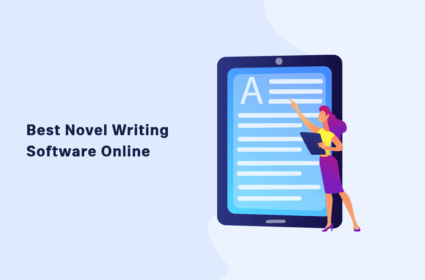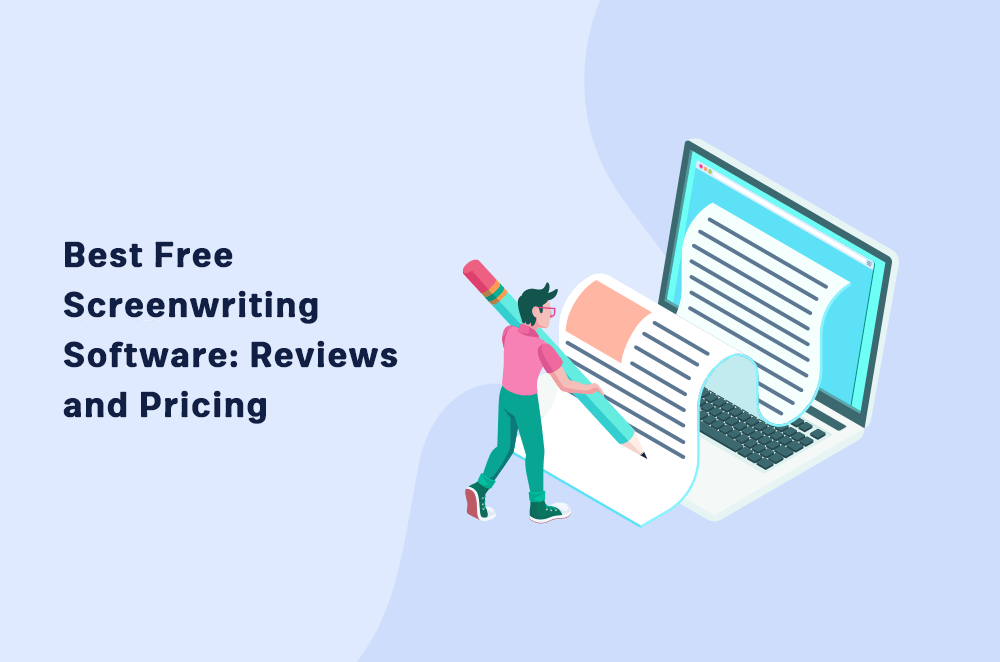Are you interested in learning everything on how to write a novel? Do you want to become the next bestselling author? Or self-publish a book? Then it’s time to write your novel with a novel software.
I am one of those writers who looks at the famous published authors and fantasize about having the same life. Their books in the flesh and on bookstore shelves. People falling in love with the world they have created.
I’ve realized to make it happen for yourself, you’ll need passion, suitable environment, resources, time, tools, and a lot of other things that will help you craft an amazing novel. Most importantly, you will need access to the best novel writing software.
A novel writing software will help you organize your research, create outline, develop characters, edit your manuscript, and help with publishing.
A great writing tool can help you become a better writer without any learning curve. It automates the process. It makes your life easier. It gives you time to focus on more strategic aspects of your creative writing that deserve your time.
But what novel writing tool is right for you? How do you find the one that will help you?
If you are not sure on where to begin, this article is for you. It covers 10 leading novel writing software in detail with their features, pros, cons, pricing details, and more.
By the time you finish reading this article, you will know what software you need and why. Trust me on this one.
1. Squibler: Best Novel Software for Speed and Simplicity
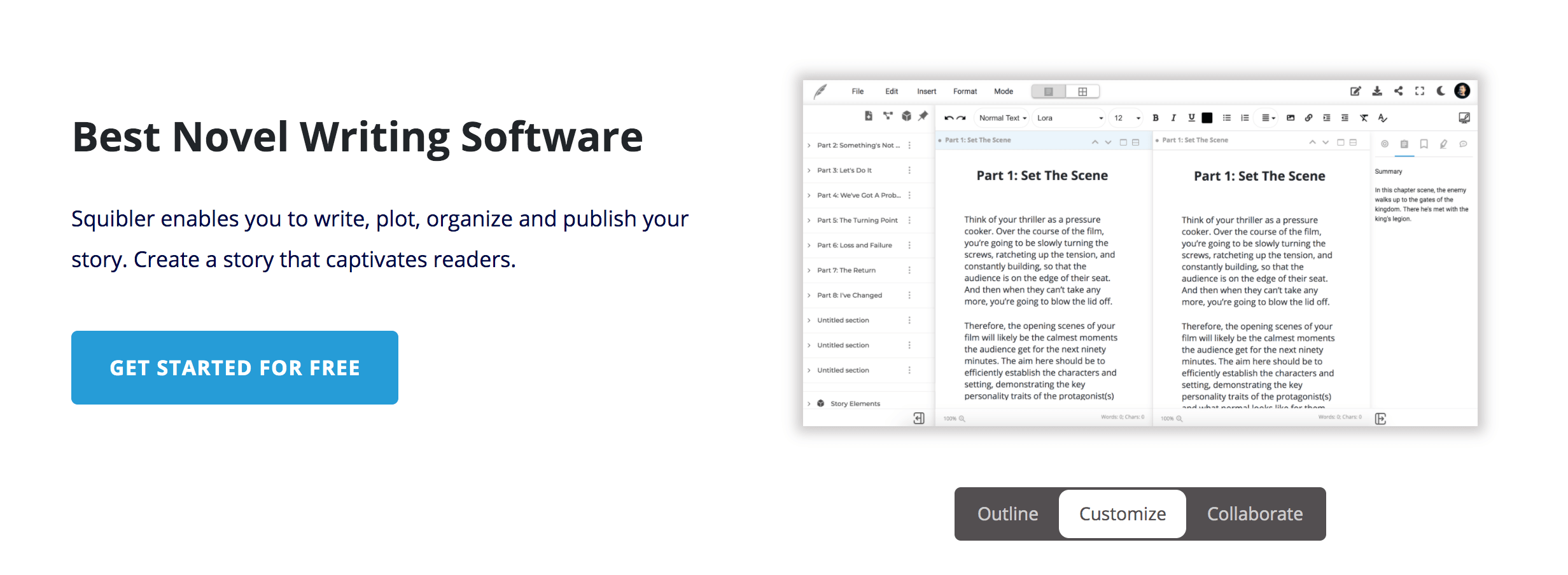
As a new novel writer, you need two things: Simplicity and speed.
A simple yet effective book software will help you get used to using software for writing. Speed will make you write fast without losing focus.
Squibler is the best novel software that is simple and speedy at the same time that helps you complete your novel fast. It works for non-fiction books, too.
It’s free to use Squibler. Not sure if it is right for you? Give it a try.
The major features and benefits of using Squibler are discussed below.
Notes
Squibler allows you to take and store notes for your project.
Notes can be anything from random brainstorming to character sketches. Whatever it is you want to have around, it will be organized for you within your Squibler project. You can add tags to your notes for better organization and management.
Outlining
Learning how to outline a novel with Squibler is easy. Whether you like to keep things minimal or go full detail, you can do it with Squibler. Organizing files in your project is fairly simple. They will be kept out of the way but will be easily accessible when needed.
Once the research and outlining are done, it’s time to write. This is where Squibler really shines.
It allows you to divide your chapters into different documents while keeping them together in your project. This allows you to move around and make changes as per need without ruining the sequence. There is no pressure to keep things in chronological order because you can just drag and drop to rearrange later. No scrolling, copying, or pasting is ever needed.
You can also create separate documents for scenes. Scenes can be moved between chapters or they can be written but kept out of place for a while until you decide a suitable place for them.
Efficiency
Squibler’s entire design is centered on the idea of efficiency. The goal is to help you write faster.
I am sure you know how hard it is to write your first draft as a writer. It can sometimes take months or even years to get through it.
Squibler eliminates this challenge by making everything easier for you. With an efficient and user-friendly design, you can spend all your time on writing without worrying about the organization, management, editing, ordering, outlining, and research. Squibler handles everything for you.
Squibler Pricing
Squibler offers the following plans:
- Free trial – enjoy the 14-day trial period which provides basic features (creating drafts, customizing templates, sharing options, etc) for free.
- Squibler Pro (monthly plan) – use its advanced features by upgrading to Squibler Pro for $9.99 per month (billed monthly).
Claim your free trial today.
2. Scrivener: An All-Round Novel Writing Software

There is writing software for almost everything from the broadest of categories to the most specific tasks. If you are looking for a versatile and not a specific writing software like Squibler, Scrivener is your best bet.
Scrivener can do a lot of things and it has a special set of advantages for writers of long-form fiction. You can buy it at a one-time price of $45.
Is Scrivener really the best novel software for you? Let’s find out.
Organization
Scrivener is a master at keeping you organized.
If you work on multiple projects at a given time (I’m sure you do), you will love this tool. Each project will involve outlines, research, notes, brainstorming, etc. Scrivener keeps all files and documents associated with a project in the same folder. One place for everything.
This is sure to keep your “projects” file clean, lean, and organized.
Research
Good novels require some level of research.
The level of research may vary, but you will definitely need to do research for your novel. Readers will relate better to your story when things are logical and believable. You need your readers to trust you if you want them to enjoy your novels.
Scrivener gives you a space within your project for all your research, then let’s your organize it with cards. It is kept out of the way but still accessible. Each project has a “binder” which lays out all sections in an organized and easy to follow way. You can create multiple documents for different areas of research.
Scrivener also allows you to import existing files for research and reference purposes. You can also keep track of links, images, and notes.
Outlining
Once you know how to write a novel, the next thing that you should know is how to outline a novel. And that’s where Scrivener fits.
You can create and manage your novel outline hassle-free.
Everyone has a different outlining style so it can be hard to pinpoint a process that will work. If you don’t know what you like to do, you will just have to go through some trial and error. Regardless of how you end up doing your outline though, Scrivener is there to help.
Plain Outlines
Outlining becomes easy with Scrivener.
You can store your outline like research by using documents and keeping them under an “outline” section within the binder. If you like seeing things in list form, this will work best for you.
It is also helpful if you like to keep everything in one central place. You can create a new document for each chapter outline, or each character, whatever works for you.
Cork Board

It is a digital cork board that functions and appears much like a real cork board. You can pin virtual note cards to a screen that looks like a cork board.
Each note card is a small rectangle that has a scroll feature. This means you can include as much information as you want on one card while keeping it small and compact.
The cork board is great for those who are more visual. You can lay out your entire novel right in front of you with the cork board. A popular way to do this is to create a note card for each chapter and set them in proper order. They can be rearranged easily by dragging and dropping.
You can create note cards for characters, scenes, settings – anything really. The cork board is extremely versatile and will suit the needs of almost everyone in one way or another.
Create Targets
Scrivener allows you to set goals and targets for writing your novel.
This is a great motivator for those who struggle with writer’s block or procrastination. There are two types of goals you can create with Scrivener:
1. Project Targets
This is a word count goal for your entire project. It is hard to know exactly how long a novel will turn out to be. But you can predict a general ballpark and set the goal.
For instance, 80,000 words is a common novel length. You can make a more educated guess if you already have a detailed outline created.
2. Session Targets
This is a small goal that you can set each time you sit down to write. Maybe you have a couple of hours and you want to bang out 1500 words. You can create a session target with that and Scrivener will start tracking you.
The targets are tracked in a small window that can be kept on the screen in a corner and out of the way. A progress bar will slowly start to fill up as you work. As you start to get closer to completion, the bar will go from red to green.
Watching your progress increase and seeing that bar go green is a satisfying reward for your efforts. It keeps you going if you get stuck or lost.
Novel Templates
There are several Scrivener templates available to choose from. A lot of these templates are created for novelists.
Scrivener comes loaded with a few basic templates. If you need more templates, you can download them free and upload them to your dashboard. There are tons of high-quality free templates available out there.
I have covered numerous Scrivener templates in this post.
A fully comprehensive template will have everything you need to write your novel seamlessly. Others will focus on one area. If you have a certain weakness that needs improvement, there is a template that will allow you to work on it while offering assistance.
Here is a list of types of templates that you can choose from:
- Story structure templates
- Outlining templates
- Plot Point templates
- World building templates
- Character sketching templates
- Instructional templates
- And many more
Scrivener Pricing
Here are the plans offered by Scrivener:
- Free trial – you can download this version if you don’t have the license for Scrivener and use it for 30 days.
- Full version – purchase the standard ($49) and educational license ($41) for your Mac and Windows. You can buy Scrivener for your iOS devices for $19.99.
You can also purchase discounted bundle plans for MacOS and Windows priced at $80.
3. Scapple: Novel Writing Software Aid for Brainstorming
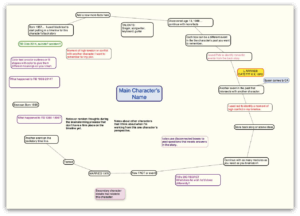
Are you more interested in a book writing software with a narrower and focused approach that lets you brainstorm and manage your novel easily?
Scapple is the novel writing tool you need.
It is a special-purpose novel writing software that helps you brainstorm and manage your notes and ideas in a clean interface.
It comes with a free trial so you can try it for free. It will cost you $14.99 should you need to purchase its full version with all the features.
Mind Maps
Are you a fan of mind maps? If so, you will love Scapple.
You can create mind maps easily with this amazing software that will help you write a novel and finish it quickly.
Scapple allows you to create digital mind maps and brainstorming notes. You can then store these notes on your computer to import elsewhere.
You can use mind maps to bring ideas and themes together in a cohesive way visually. It helps you get rid of the chaos during the ideation and process.
Here is an example of how your mind map will look like:
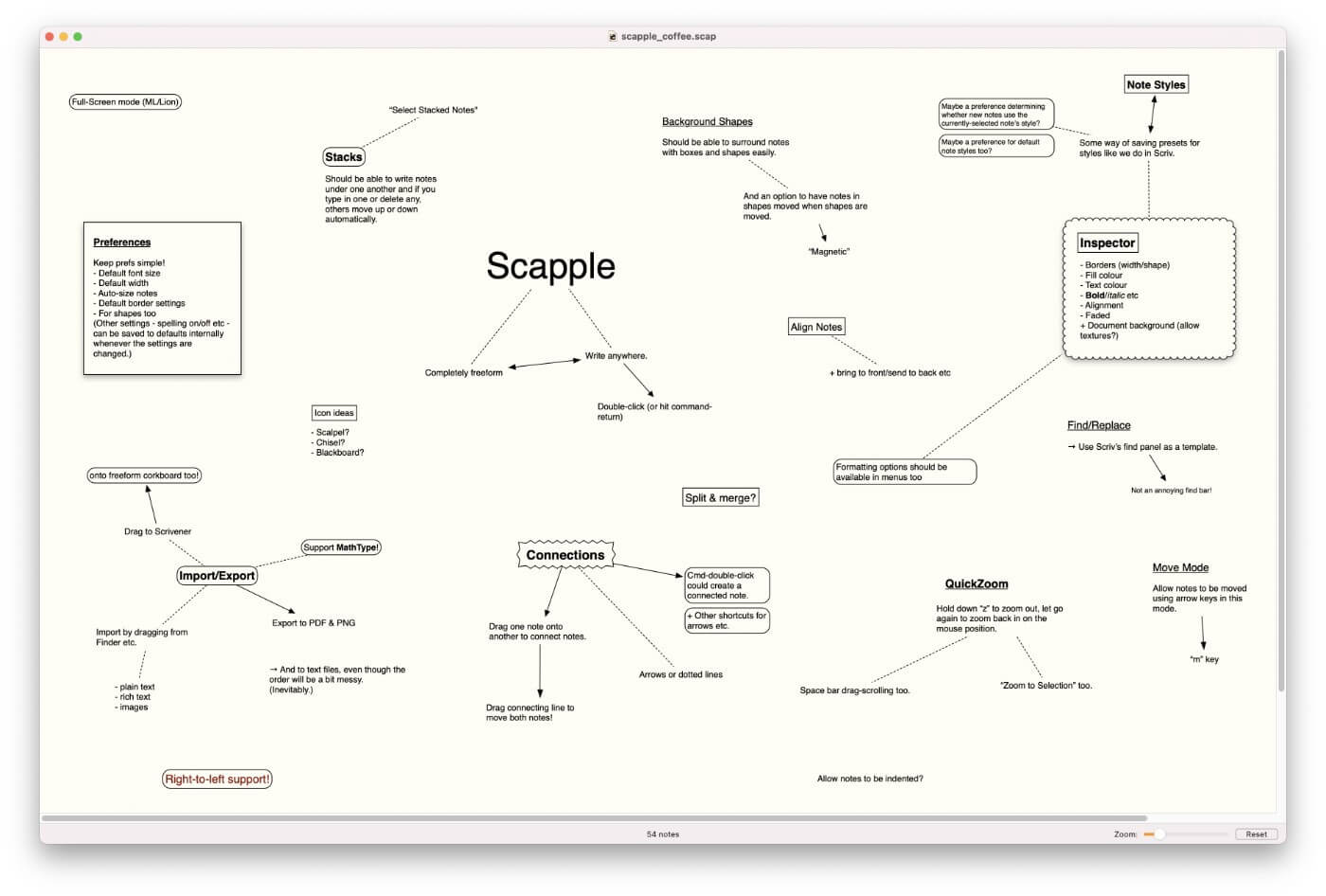
Scapple is an easy-to-use tool. Once you open the program, you can click anywhere on the blank document to create a note. You can create unlimited notes and put them wherever you want.
Notes can be connected to each other by dragging them around. You can customize shape and structure of the notes easily.
No hiccups. It’s fun and interesting.
Scapple Pricing
Scapple offers the following plans:
- Free trial – download Scapple for free and enjoy a 30-day free trial.
- Paid version – buy the standard license ($18) and educational license ($14.40) for your MacOS and Windows systems.
4. ProWritingAid: Novel Writing Software Aid for Editing

Knowing how to write a novel is one thing and having it edited is something else. You cannot go without editing your novel.
And when it comes to editing your novel, the best software is none other than ProWritingAid.
It is an editor that provides both grammar and style corrections and suggestions. It has a free version with limited features. You can only check 500 words at a time with the free version. This can be tedious and annoying if you are trying to edit a long project. The premium plan starts at $60 per year. You can get lifetime access for as low as $210.
Upgrading to the premium version has several additional benefits such as:
- A downloadable desktop app to work offline.
- No word limit.
- Real-time grammar and style checking.
- Integrates with Microsoft Word, Google Docs, Chrome, and Scrivener.
- It provides 25 different writing reports on each piece of analyzed writing.
Writing Reports
This is one of the best features of ProWritingAid. It looks at your writing from 25 different perspectives which cover all styles of writing – including fiction.
The reports you will get once your writing has been analyzed are discussed below.
1. Writing style: This will highlight instances of passive voice, adverbs, and repetition.
2. Grammar: Misuse of commas, sentence fragments, and incorrect use of tense are some of the grammar issues it will pick up.
3. Overused words: It finds words that are overused and ineffective.
4. Clichés and redundancies: Finds clichés within your text and suggests how they can be removed. Redundancies are things like “She clapped her hands.” The mention of hands is unnecessary as hands are (most likely) the only thing anyone would be clapping.
5. Sticky sentences: Identifies sentences that may feel or sound awkward due to unnecessary words. These sentences can interrupt the flow and make readers feel stuck.
6. Repeats: Highlights words or phrases that are used often throughout the text.
7. Sentence length: Gives you an overall view of how long your sentences are. This allows you to see where you might want to add some variety. Changing sentence length provide a good flow whereas multiple long or short sentences in a row can start to sound redundant and boring.
8. Pronouns: Gives you a pronoun percentage. Too many pronouns can make things feel repetitive.
9. Transitions: This gives you the percentage of sentences that contain a transition. ProWritingAid suggests that at least 25% of sentences should have them.
10. Consistency: Checks for spelling, punctuation, and capitalization.
11. Dialogue tags: Excessive use of dialogue tags can slow the pace of your story. (Lucy shouted and Cassie said are examples of dialogue tags).
12. Readability: This report provides a score for your piece in 4 different ways based on certain guidelines. You can compare it to the specific guidelines and see how it stacks up.
13. Vague and abstract words: Identifies words that are abstract, vague, or otherwise ineffective. Depending on your intended audience, it may be better to stick to simpler words that are easily identified and understood by all.
14. Thesaurus: A report that will suggest possible replacement words – it is only programmed for shorter pieces, however.
15. Diction: Identifies complicated writing and suggests ways to fix it.
16. Alliteration: Alliteration is when multiple words in a row begin with the same letter. It can be effective in some instances but it should not be used excessively. This report highlights all uses of alliteration.
17. Homonyms: Checks for words like break and brake – they sound the same but actually spelled differently.
18. Corporate wording: Language that is complex and fancy. Too much of this can sound pretentious and unnecessary.
19. Complex words: It identifies words that contain three or more syllables. You can then decide if any should be simplified or replaced.
20. Eloquence: Identifies some stylistic techniques.
21. Combo: This simply allows you to pick which of the reports are most helpful and relevant to you so you can more easily use them.
22. House style: This is a feature that allows you to create your own rules within ProWritingAid. For example, you can tell it to check for a word you know you have a habit of overusing.
23. Plagiarism: Points out any duplicated material so you can change it or properly credit the information to the source.
This list of reports may seem long and tedious – and that’s because it is. However, if you take the time to pay proper attention to each one, it will benefit you in many ways. You will be able to optimize your novel and improve it to a great extent.
If you make a habit of using and reading these reports, you will become a better writer. You will begin to take notice of the mistakes you make repeatedly. You will learn what makes your writing sound great and what makes it sound clunky.
Eventually, this will become second nature and you’ll be writing it correctly the first time around.
ProWritingAid Pricing
ProWritingAid has the following subscription offers:
- Monthly – $20/ month
- Yearly – $79/ year
- Lifetime – $299 (one-time payment)
Monthly users can switch to yearly subscription and save 67%.
5. AutoCrit: Word Processor for Better Writing
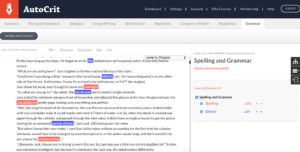
AutoCrit is an incredibly useful editing software with a unique purpose. This novel writing software analyzes your for originality. It begin by checking for simple grammatical errors that are crucial for great writing:
- Repetition
- Pacing
- Vague dialogue
- Weak sentences
- Poor grammar
AutoCrit is special in the sense that it goes beyond these basics and focuses on the overall success of your book. It takes your genre into consideration and compares your work to that of professional authors who are already published. It tells you how to stack up while ensuring you aren’t copying anyone.
If you have a particular well-known author whose style you really enjoy and wish to emulate, AutoCrit will help you with this too. Select from a list of highly recognized authors and receive customized recommendations for your writing.
This is an amazing tool if you’re pursuing self-publishing. Even if you’re interested in going the traditional route, it is still helpful as it shows you how your writing stacks up to the professionals.
AutoCrit Pricing
AutoCrit offers the following plans:
- Free – don’t pay a dime to get access to the basic features.
- Professional – $30/month
- Annual Professional – $297/year
6. Evernote: Program for Note Taking
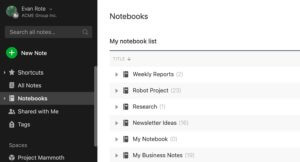
Do you like taking notes during the process? Do you like to keep things organized? If so, you need to use Evernote.
Evernote is an app to create, manage, and organize your notes across multiple devices.
It helps you take notes on the go. It is simple, feature-rich, easy-to-use, and an effective note taking app.
You can keep multiple notes in a single notebook with Evernote. This is ideal for novelists as you can create multiple notebooks each for a different project. You can create a separate notebook for each novel that you are working on.
Evernote comes with a free version that allows you to create awesome notes but you can also subscribe to the premium for $9.99/month.
The notes you can create with Evernote have a lot of different options and capabilities. In addition to all the usual formatting options (font, bold, italics, bullet lists, etc.), a note can do a lot of cool things:
- Include direct links to anywhere on the web.
- Insert the entire webpage or sections of a webpage with the web clipper extension.
- Tag notes for easy organization and searching.
- Import content from Microsoft OneNote.
- Export as HTML or webpage for use with other services and programs.
- Attach files from your computer right into the note.
- Print your note or convert it to PDF.
- View note history.
- Share a note with an individual or on social media
You can enjoy additional benefits if you upgrade to a paid plan:
- Monthly upload limit increase from 60MB to 10GB.
- Maximum note size increase from 25MB to 200MB.
- The of devices that can be used goes from 2 to unlimited.
- Offline access is available on desktop and mobile (mobile not available with basic).
- Increased customer support access through email and live chat.
Evernote Pricing
Evernote offers the following plans:
- Basic – this is a free plan.
- Premium – $7.99/ month with a free 30-day trial period.
- Business – $14.99 per user per month with a free 30-day trial period.
7. Dramatica: Novel Writing Software for Character Development
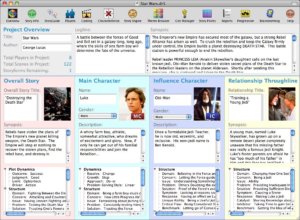
Character development is a crucial element of any novel. Regardless of the story’s focus, characters are always important. It is generally recommended that you create your main character(s) well before you begin writing. Adding character sketch in the outline will help too.
But how you get better at character development? What software to use?
The simple answer is: Dramatica.
Dramatica is a novel writing software that focuses on characters and their development. It helps you stay consistent with your characters in terms of their personality, actions, and decisions.
The software allows you to map out the narrative for each individual character with in-depth detail. You can plot their milestones and crucial moments and keep track of how they relate to the theme of your story.
The idea is to let you create and follow your story from the perspective of your main character. These detailed but flexible character profiles help eliminate plot holes and inconsistencies as you are able to see the whole picture from all sides.
Dramatica doesn’t just help with character development and management rather it also suggests improvement based on your theme.
Perfect Your Structure
Dramatica has what they call a “Master Story Engine” which picks the exact structure of your story. This goes beyond the few basic or typical structures rather it is pulled from a database of over 30,000 unique variations of your story’s structure. Their algorithm can quickly identify what elements of the story and the structure are most important for the writer.
Dramatica Pricing
Dramatica offers the following plans:
- Dramatica Story Expert (for Mac) – starts at $139.95
- Dramatica Pro (for PC) – starts at $119.95
Visit Dramatica for details.
8. Microsoft Word

Microsoft Word is a word processor that offers a suite of productivity features. Most writers are already familiar with this tool. That means the learning curve maybe non-existent for you.
In Word, you can use headers to organize your chapters and a navigation pane to go through them. Moreover, Microsoft Word offers many templates and basic grammar correction functionality. With the online version, you can collaborate with co-authors and editors, making this an exceptional tool to use for a novel.
Better yet, most writers and editors still prefer Microsoft Word. This means you’re more likely to find an editor who will want to work with you if you started your novel on the platform.
Microsoft Word Pricing
Here is the pricing list for Microsoft Office:
- Family – $79.99/ year or $7.99/ month with a free 30-day trial period
- Personal – $59.99/ year or $5.99/ month
- Student – $119.99 one-time purchase.
- Business – starting from $5 to $8.25 per user per month
9. Grammarly

Grammarly is a grammar checker and one of the best programs for ensuring your grammar is mistake-free. It’s free to use with unlimited documents. It works through a Chrome extension that enables these corrections anywhere you write on the web whether that be on another platform like Squibler or Google Docs.
Grammarly Pricing
Grammarly offers the following plans:
- Free – enjoy the basic features for free.
- Premium – upgrade to the premium version for $29.95/ month (billed monthly), $19.98/ month (billed quarterly), and $11.66/ month (billed annually).
10. Ulysses
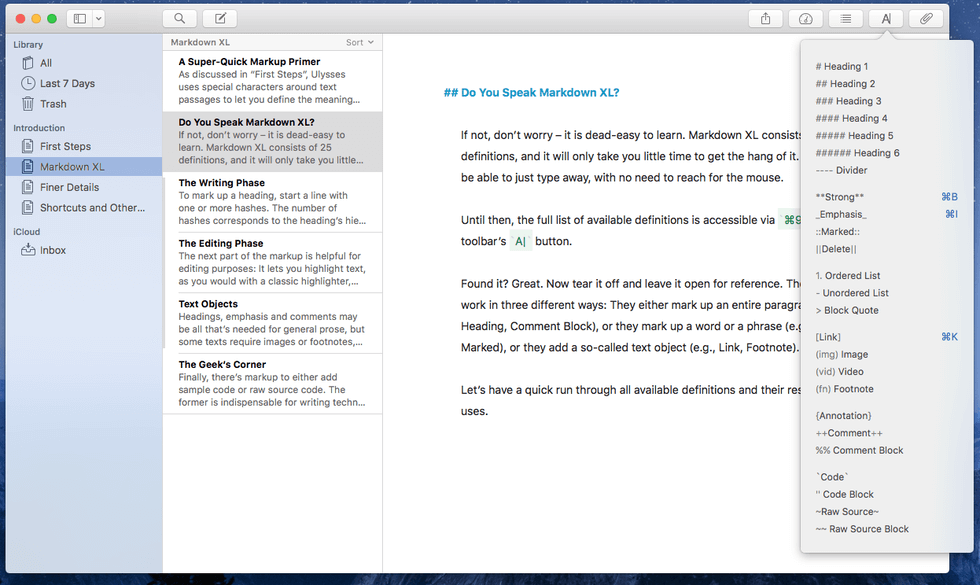
Ulysses is a Mac-based program and word processor available in the Mac OS and iOS app store. It syncs files to Apple’s iCloud, which means it works with a good part of Apple’s ecosystem.
Ulysses has one Library for all of your documents, full version history of revisions, and the ability to strip away menu options for distraction-free writing. Moreover, you can use Ulysses to export your work in Plain Text, PDF, HTML, Markdown, DOCX, and EPub.
The downside is there are no templates and collaboration features. As a result, many writers may favorite it for note taking over using it as a novel writing software.
Ulysses Pricing
Ulysses offers the following plans:
- Student license – $10.99 for six months ($1.83/ month)
- Monthly plan – $5.99/ month
- Yearly plan – $49.99 ($4.17/ month)
Try Ulysses for free.
Choose the Best Novel Software Today
These are a list of the best novel writing software which are sure to help you write your first novel that readers will fall in love with.
It should be noted that a software or a book writing tool doesn’t write for you rather it helps you write better. The purpose of using these writing software and tools is to get organized, improve speed, and get things professionally done.
These tools simplify novel writing which is a complicated and complex task.
Download your favorite novel writing software form the list above, sign up for a free trial, explore their features, figure out how it will help you in the writing process, and if it turns out to be a decent match, switch to a premium plan.
Good luck.
Frequently Asked Questions
Here is a list of answers to the most common questions about novel writing software:
What is the best software for writing a novel?
The best novel writing software is Squibler. Squibler is a word processor with built in outlining and writing tools that are perfect for novel writers. It has the ability to compile all of your ideas into an easy-to-follow outline, which will help you stay on track as you write your book.
It also comes with other features like brainstorming templates, comprehensive formatting options, research panels, and more.
What is novel writing software?
Novel writing software helps writers organize their thoughts, structure their novel’s plot and chapters, keep track of timeframes, and edit drafts as well as publish it to an audience.
Do you need novel writing software?
That’s up to you. Some writers like the idea of outlining their novel in a long-form document before writing, while others prefer to just jump into it and write organically from there.
